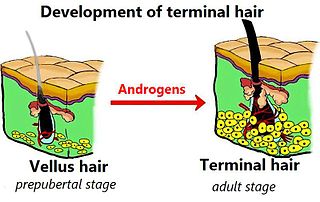
Alopecia areata, also known as spot baldness, is a condition in which hair is lost from some or all areas of the body. Often it results in a few bald spots on the scalp, each about the size of a coin. Psychological stress may result. People are generally otherwise healthy. In a few, all the hair on the scalp or all body hair is lost and loss can be permanent.

Minoxidil is an antihypertensive vasodilator medication, available as a generic medication and over the counter for the treatment of androgenic alopecia, a form of hair loss, in people.

The hair follicle is a dynamic organ found in mammalian skin. It resides in the dermal layer of the skin and is made up of 20 different cell types, each with distinct functions. The hair follicle regulates hair growth via a complex interaction between hormones, neuropeptides and immune cells. This complex interaction induces the hair follicle to produce different types of hair as seen on different parts of the body. For example, terminal hairs grow on the scalp and lanugo hairs are seen covering the bodies of fetuses in the uterus and in some new born babies. The process of hair growth occurs in distinct sequential stages. The first stage is called anagen and is the active growth phase, catagen is the resting stage, telogen is the regression of the hair follicle phase, exogen is the active shedding of hair phase and lastly kenogen is the phase between the empty hair follicle and the growth of new hair.

Telogen effluvium is a scalp disorder characterized by the thinning or shedding of hair resulting from the early entry of hair in the telogen phase. It is in this phase that telogen hairs begin to shed at an increased rate, where normally the approximate rate of hair loss is 125 hairs per day.

Alopecia universalis (AU) or alopecia areata universalis is a medical condition involving loss of all hair, including eyebrows and eyelashes. It is an advanced form of alopecia areata.
The management of hair loss, also known as alopecia or baldness, may include medications and surgery.

Alopecia totalis is the loss of all skull and facial hair. Its causes are unclear, but believed to be autoimmune.

Hair transplantation is a surgical technique that removes hair follicles from one part of the body, called the 'donor site', to a bald or balding part of the body known as the 'recipient site'. The technique is primarily used to treat male pattern baldness. In this minimally invasive procedure, grafts containing hair follicles that are genetically resistant to balding are transplanted to the bald scalp. Hair transplantation can also be used to restore eyelashes, eyebrows, beard hair, chest hair, pubic hair and to fill in scars caused by accidents or surgery such as face-lifts and previous hair transplants. Hair transplantation differs from skin grafting in that grafts contain almost all of the epidermis and dermis surrounding the hair follicle, and many tiny grafts are transplanted rather than a single strip of skin.
A hair prosthesis is a custom-made wig specifically designed for patients who have lost their hair as a result of medical conditions or treatments, such as alopecia areata, alopecia totalis, trichotillomania, chemotherapy, or any other clinical disease or treatment resulting in hair loss. The terminology is used when applying for medical insurance or tax deduction status.

Pattern hair loss, known as male-pattern hair loss (MPHL) when it affects males and female-pattern hair loss (FPHL) when it affects females, is hair loss that primarily affects the top and front of the scalp. In males, the hair loss often presents itself as a receding hairline, while in females, it typically presents as a thinning of the hair.
Ophiasis is a form of alopecia areata characterized by the loss of hair in the shape of a wave at the circumference of the head.
Madarosis is a condition that results in the loss of eyelashes, and sometimes eyebrows. The term "madarosis" is Greek for the word "madao" which means "to fall off." It originally was a disease of only losing eyelashes but it currently is the loss of both eyelashes and eyebrows. Eyebrows and eyelashes are both important in the prevention of bacteria and other foreign objects from entering the eye. A majority of patients with madarosis have leprosy, and it was reported that 76% of patients with varying types of leprosy had madarosis.
Anagen effluvium is the pathologic loss of anagen or growth-phase hairs. Classically, it is caused by radiation therapy to the head and systemic chemotherapy, especially with alkylating agents.
Scarring hair loss, also known as cicatricial alopecia, is the loss of hair which is accompanied with scarring. This is in contrast to non scarring hair loss.
Non scarring hair loss is the loss of hair without any scarring being present. This is in contrast to scarring hair loss.

Trichoscopy is a method of hair and scalp evaluation and is used for diagnosing hair and scalp diseases. The method is based on dermoscopy. In trichoscopy hair and scalp structures may be visualized at many-fold magnification. Currently magnifications ranging from 10-fold to 70-fold are most popular in research and clinical practice.
Frontal Fibrosing Alopecia is the frontotemporal hairline recession and eyebrow loss in postmenopausal women that is associated with perifollicular erythema, especially along the hairline. It is considered to be a clinical variant of lichen planopilaris.
Scalp dysesthesia or trichodynia is a cutaneous condition characterised by pain and burning sensations without objective physical examination findings. The pain sometimes is described as burning. Often there is an underlying psychosomatic cause, such as stress, depression or anxiety.
The growth of human hair occurs everywhere on the body except for the soles of the feet, the lips, palms of the hands, some external genital areas, the navel, scar tissue, and, apart from eyelashes, the eyelids. Hair is a stratified squamous keratinized epithelium made of multi-layered flat cells whose rope-like filaments provide structure and strength to the hair shaft.

Setipiprant (INN) (developmental code names ACT-129968, KYTH-105) is an investigational drug developed for the treatment of asthma and scalp hair loss. It was originally developed by Actelion and acts as a selective, orally available antagonist of the prostaglandin D2 receptor 2 (DP2). The drug is being developed as a novel treatment for male pattern baldness by Allergan.












